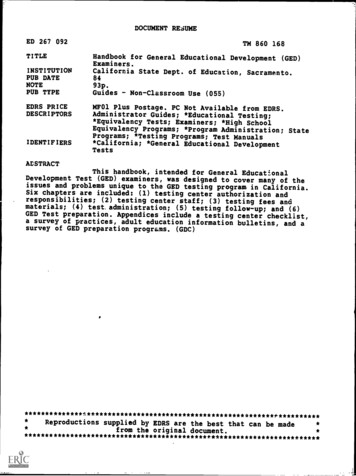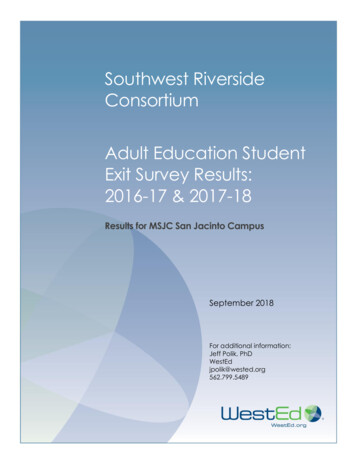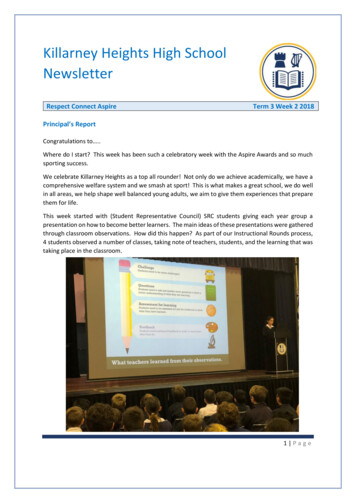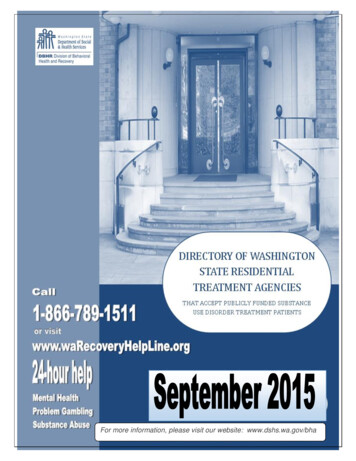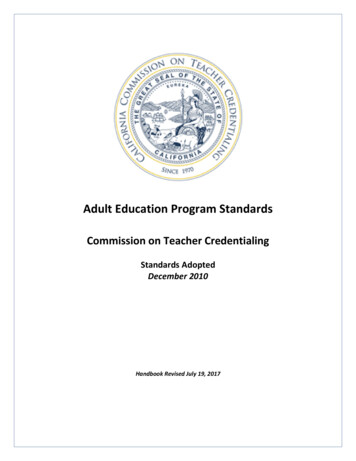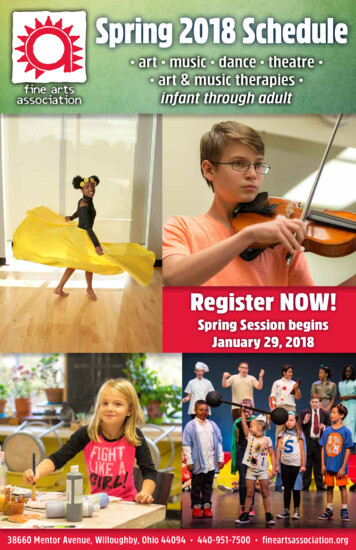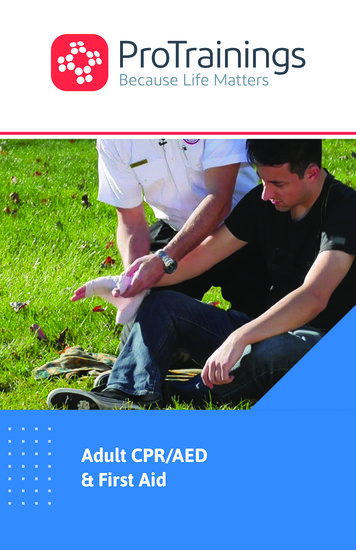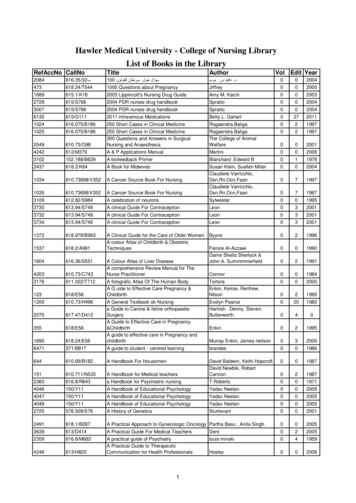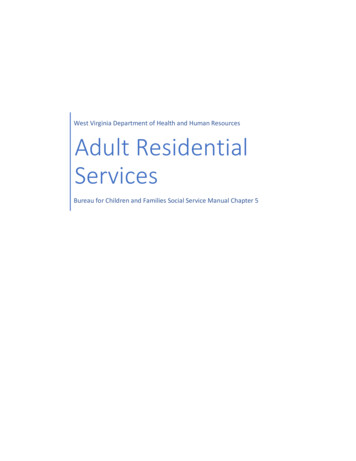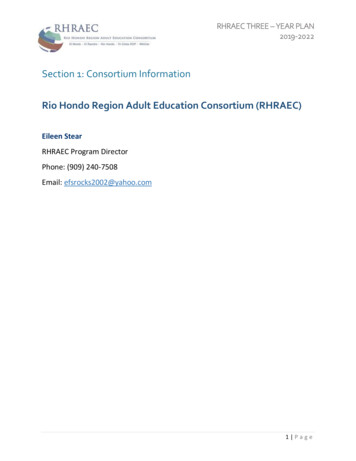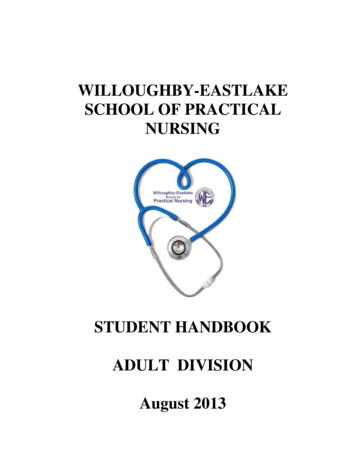
Transcription
WILLOUGHBY-EASTLAKESCHOOL OF PRACTICALNURSINGSTUDENT HANDBOOKADULT DIVISIONAugust 2013
Willoughby-EastlakeSchool of Practical NursingThe purpose of Willoughby-Eastlake School of Practical Nursing is to prepare licensed practicalnursing students to practice nursing to meet the dynamic health care needs of individuals andfamilies within our community. Faculty facilitate the education of students in the art and scienceof nursing to provide ethical, holistic, and cultural competence in nursing in collaboration with avariety of health care systems. Nursing competencies such as safe skill and practice, clinicaljudgment, critical thinking, advocacy, and response to diversity are core components in thepreparation of the nurse.FacultyLori Klonowski BSN, RN, M. Ed, Director of ty Schultz, Administrative t Carter, Financial Aid Officer440-602-5094Cindy Adams, BSN, RNCindy.Adams@weschools.orgKrista Angell, M Ed, BSN, RNKrista.Condit@weschools.orgConnie Bowler, MSN, RNConnie.Bowler@weschools.orgLori Koncsol, M. Ed., BSN, RNLori.Koncsol@weschools.orgLisa Kovacic, M Ed., BSN, RNLisa.Kovacic@weschools.orgMary Mills, MSN, RNMary.Mills@weschools.orgKim Nye, M Ed., BSN, RNKimberly.Nye@weschools.orgSharon Stockwell, MSN, RNSharon.Stockwell@weschools.org2
FORWARDDear Student:We are very happy that you have decided to pursue a nursing career at the Willoughby-EastlakeSchool of Practical Nursing. We hope that the time spent with us will be an exciting andchallenging learning experience.Please take a few moments to read through this handbook, so that you are aware of procedures,policies, and responsibilities specific for nursing students. We would appreciate your signingand returning the last page of this handbook to your instructor.3
TABLE OF CONTENTSStudent Handbook 2013 – 2014Acceptance of StudentsAccess in NursingAcknowledgementAdmission RequirementsAdvance PlacementAffiliating AgenciesAmerican Disability ActAnti-HarassmentApproval & AccreditationAttendanceAttendance ProcedureCell Phone PolicyCalamity DaysChemical AbuseClass RequirementsConceptual FrameworkConceptual Framework GraphConduct - StudentControlling AgencyCourse DescriptionsDirect Loans & Pell GrantsDirector of SchoolDisclaimer StatementDisclosure StatementsDismissalDriving and Parking PermitsExtracurricular ActivitiesFinancial Aid PoliciesFingerprinting/Background 15194533Follow-up & Placement34Grading & Evaluation Policies30Graduation/Completion33Grievance & Appeal32Guidance & Counseling30Harassment Compliant Form28History5Legal Name of School & Phone Number7Liability king Permits/Rules & Regulations15Philosophy6Physical Requirements (ADA)10Probation31Program Description14Progression & Periodic Evaluation31Readmission34School Calendar44Smoking23State Board of Nursing Exam (See NCLEX-PN)Student Health Program12Transcript Service34Tuition Policy16Uniform Policy17Uniform Regulations17Vacations & Holidays16Withdrawal324
WILLOUGHBY-EASTLAKE SCHOOL OF PRACTICAL NURSINGADULT DIVISIONHISTORYThe Willoughby-Eastlake School of Practical Nursing adult program opened its doorsSeptember 1962; to educate those interested in becoming practical nurses, and to helprelieve the nurse shortage.The program has grown and developed to accommodate society growth and advancementof technology. Since then, there have been 80 graduating classes.In 1962, the Willoughby-Eastlake School City School District started an adult practicalnursing program at the request of the Board of Education. This assisted the growingcommunity meet the need for health care providers.Both the high school and adult programs are nine (9) months in length. The first semesteris mainly basic nursing theory and the introduction to patient care with hands-onexperience. The second semester is devoted to hospital and patient experience, theinstruction in medical-surgical nursing and advanced specialty areas. The students, inboth semesters usually attend English and/or Social Studies classes daily.Upon graduation from the high school and the adult program, the graduate is eligible totake the NCLEX Examination to be licensed as a Practical Nurse.Willoughby-Eastlake has been dedicated throughout the years to educate nurses and toprovide excellence in nursing at both the bedside and in the preventative health caresettings under the auspices of a registered nurse, doctor, dentist or podiatrist. Ourgraduates have been successfully employed in hospitals, home health care, clinics, doctors'offices, private duty, nursing homes, prisons, and military. Many continue their educationand become a registered nurse.5
WILLOUGHBY-EASTLAKE SCHOOL OF PRACTICAL NURSINGPHILOSOPHYThe faculty believes that nursing education is a deliberate process of learning by the studentinterested in providing nursing care to others. In order to facilitate this learning process, webuild our curriculum on these concepts:WE BELIEVE.- the person is a holistic being who is an individual, a member of a family, a member ofa local, regional, and world community. Each person possesses individual, physical, emotional,social, economic, and spiritual self-care requisites. Either self-care agency, dependent-careagency, or nursing-care agency can meet these self-care requisites.- health exists when the person has the ability to meet self-care requisites that contributeto the maintenance and promotion of structural and/or emotional integrity, functioning, anddevelopment. Illness occurs when an individual is incapable of maintaining self-care as a resultof health-related limitations. society/environment includes all internal and external factors which effect theperson's ability to adjust or maintain self-care agency or meet self-care needs. nursing is a service of deliberately selected and performed actions to assist individualsto maintain self-care, including structural integrity, functioning, and development. These actionsshould be based on the organized approach of nursing process which includes the following:- collect and record objective and subjective data to facilitate the assesssment of the individual/patient in terms of self-care, development and health deviationrequisitiesidentifying problems specific to the individual/patient and their unmet healthcare requisitesusing a cooperative effort with the individual/patient to establish goalsestablish a plan of care using appropriate members of the health care team andthe individual/patientimplement the planevaluate and revise the plan of care as necessary nursing education is the process by which the nursing instructor facilitates thestudent's psychomotor, cognitive, and affective skills to attain an entry level of nursingknowledge and competency. Entry level practical nursing skills are learned through the use ofintegrated Technical and Academic Competencies.Program Curriculum - The core of knowledge obtained in this curriculum is viewed as a basisfor beginning practice in the nursing field. It is stressed to the student that as a member of a verydynamic profession, accountability for current knowledge is ever present. A continuous processof learning is emphasized because of constant changes within the study of the science of nursing.6
LEGAL NAME OF SCHOOL, ADDRESS AND PHONE NUMBERWilloughby-Eastlake School of Practical Nursing34050 Glen Drive, Suite 2Eastlake, Ohio 44095440-602-5094440-942-6983 FAX1-800-750-0750 - Ohio Relay Service (TTY/Voice)APPROVAL AND ACCREDITATIONThe school is approved by the.Ohio Board of NursingOhio Department of Education, Career and Technical EducationThe Ohio Board of RegentsNorth Central AssociationCONTROLLING AGENCYWilloughby-Eastlake Board of EducationSuperintendent of Schools: Steven ThompsonADMINSTRATOR OF SCHOOL OF PRACTICAL NURSINGLori Klonowski, M. Ed., BSN, RNAFFILIATING AGENCIESLake Health -- West - Willoughby, Ohio - Acute CareLakeMed Nursing & Rehabilitation CenterGateway Health CenterWaterford at Richmond HeightsLake County MRDD – Broadmoor 9800440-602-1000LIABILITY INSURANCEStudent Malpractice Blanket Liability provided by:7Marsh Affinity Group Services1440 Renaissance DrivePark Ridge, IL 60068a service of SEABERY & SMITH
ADMISSION REQUIREMENTS1.All candidates for admission to the Willoughby-Eastlake School of Practical Nursing areconsidered on individual merits, without discrimination on the basis of age, creed,national or ethnic origin, race, color, sex, marital status, handicap, political affiliations orbeliefs.2.Educationa.Candidate must have a high school diploma or passing G.E.D. scores for Ohio3.Pre-entrance Testsa.Passage of the ACT Work Keys Test with a score of Level 5 or above onApplied Mathematics and a score of Level 4 or above on Locating Information4.Personal Qualificationsa.References from two persons, preferably from an employer, guidance counseloror teacher.b.Integrity, responsibility, honesty, emotional stability, and a commitment to thewell being of others are personal qualities that, to a great extent, determine theability of a student to succeed in nursing.c.Evidence of such characteristics is drawn from information provided in theapplication form, high school record, and from the personal interview ororientation.5.Health Requirementsa.A physician’s report of physical examination before entrance to school.b.Immunization as required by the program.c.Satisfactory results of skin test for tuberculosis.American Disability ACT (ADA)The Willoughby-Eastlake School of Practical Nursing supports the concepts embraced inthe American Disability Act of 1990, Section 503 and 504 of the Rehabilitation Act of1973. Enrollees must be able to successfully complete the academic and clinicalobjectives of the program in a timely manner, implementing the essential functionsintegral to the program. Individual, personal, and reasonable accommodations will beinstituted to facilitate opportunities for the enrollee.8
ADMISSION REQUIREMENTS (Continued)American Disability Act (ADA) (continued)The following are the minimal physical and mental qualifications necessary to functionas a practical nursing student within this vocational educational program. The ability to lift, move, or assist in moving clients of all age groups and weights up inthe bed, into wheelchair, into bathroom and elsewhere within the healthcareorganization.The ability to move around the client’s room and in work areas efficiently, accurately,safely and in a timely manner.Visual acuity sufficient to observe and assess client’s behavior, prepare and administermedications, and accurately read monitors.Auditory acuity sufficient to hear instructions, requests and monitoring alarms and toauscultate heart sounds, breathe sounds, and bowel sounds.Gross and fine motor abilities sufficient to provide safe and effective nursing care.Tactile ability sufficient for physical assessment, safe medication administration, andimplementation of client care.The ability to provide effective written, oral and nonverbal communication with clientsand their families, colleagues, health care providers and the public.The ability to speak, write and comprehend the English language proficiently.The ability to communicate via computer in the classroom and at clinical sites.Critical thinking ability sufficient in clinical environment for safe, prudent judgments.Interpersonal abilities sufficient to interact with individuals, families, groups, staff,faculty, and peers from a variety of social, emotional, cultural and intellectualbackgrounds.Compassion, integrity, interest and motivation expected of a developing health careworker.The ability to adhere to ethical standards of conduct as well as applicable state andfederal laws.Emotional maturity and stability to approach highly stressful human situations in a calmand rational mannerThe enrollee must be able to perform these essential functions with efficiency, accuracy, safely,and in a timely manner to successfully complete the program outcomes.Physical and mental expectations are provided as a sampling and in no way ismeant to be limited to or an inclusive listing of expectations.9
PHYSICAL REQUIREMENTS (continued)ADA (continued)PerformanceStandardExamples of Necessary Activities(Not all inclusive)Physical StrengthThe ability to assist in liftingor moving clients of all agegroups and weightsLift up to 35% of recommended bodyweight, lifting up to 20# equipmentand supplies, lift up to 50# positionclient, over 50# when transferringclientMobilityThe ability to move aroundthe client’s room and inwork areasStand and/or walk 6-8 hours a day;walk rapidly for a period from onearea to another; bend or squatfrequently; provide care for a client inan elevated hospital bed or stretcher;provide nursing care for client in avariety of positions requiringstanding, stooping, bending, reachingand handling; perform one-manVisual AcuityThe visual acuity sufficientto observe and assess clientbehavior, prepare andadminister medications andread monitorsObserve client responses at a distanceand close at hand; visually perceivethree dimensional relationships andspatial relationships or objects; ableto differentiate to color spectrum forcolor coding of charts and monitoringequipment.Auditory AcuityAuditory acuity sufficient tohear instructions, requestsand monitoring alarms,breath sounds and bowelsoundsHear sufficiently to detect subtlechanges in client’s conditions; hearsufficiently to interpret variousequipment signalsMotor SkillsGross and fine motorabilities sufficient to providesafe and effective nursingcarePerform physical assessmenttechniques including: inspectionauscultation, palpation andpercussion. Safely implement nursingprocedures/skills I a timely andefficient manner. Calibrate and useequipment. Position and turn clientsincluding pinch, grip, pushing and/orpulling carts/wheelchairs. Assistingin movement of clients, medical filesand moving equipment. Preparationand administration of medications.10
PerformanceStandardExamples of Necessary Activities(Not all inclusive)TactileTactile ability sufficient forphysical assessmentPerform palpation, auscultation,percussion and functions of physicalexamination.TouchAbility to handle andmanipulate; offer client care.Those related to therapeuticinterventions to and when offeringstandard nursing care measures.CommunicationThe ability to provideeffective written, oral andnonverbal communicationwith clients and theirfamilies, colleagues, healthcare providers and thepublic; the ability to speak,write and comprehendEnglish proficiently.Explain treatment procedures, initiatehealth teaching, document andinterpret nursing actions and clientresponses. Give oral and writtenreports to other members of the healthcare team charting client data.Operate communication methods atthe clinical site. Includes fingerpresses when keyboarding.Critical ThinkingCritical thinking abilitysufficient for clinicaljudgment.Identify cause and effect relationshipsin situations; develop nursing careplan for assigned client(s)InterpersonalInterpersonal abilitiesEstablish effective rapport withsufficient to interact withclients, team members, peers andindividuals, families, groups, faculty.faculty, staff and peers froma variety of social,emotional, cultural andintellectual backgrounds.Social BehaviorCompassion, integrity,interpersonal skills, interestand motivation.Develop a mature, sensitive andeffective relationships with clients,peers, faculty and staffEthical BehaviorThe ability to adhere toethical standards of conductas well as applicable stateand federal laws.Demonstrate behavior consistent withthe practical nurse code of ethicsStress ManagementEmotional maturity andstability to approach highlystressful human situations ina calm and rational mannerEffectively practice personal andprofessional behaviors in atherapeutic and constructive manner.11
ACCEPTANCE OF STUDENTSis based upon:1) The Director of nursing reviews:a)b)c)d)e)f)g)h)i)High School Transcripts or G.E.D. equivalencyPre-Entrance Test RequirementCompleted application formStudent Orientation or InterviewSatisfactory medical examinationTwo letters of referencePayment of tuition prior to entry into the programCurrent Mantoux Skin test or Chest X-ray, current immunizationsBCI & I background check2) Admissions Committee Responsibility:a) Director shall present acquired information on applicant to Admissions Committee.b) The committee shall accept, reject, place on probation, or defer all applicants submitted.STUDENT HEALTH PROGRAMThe student health program is operated for the purpose of promoting and maintaining the healthof the students. In order to better serve the health needs of the students, the following policiesare in effect:1.Pre-admissionPhysical examination - student’s own physician will do this examination. All tests atthe discretion of the examining physician. The doctor's decision is final regardingunusual health problems of the student. Exams and tests are at the student's expense.Immunization - Immunization for tetanus, diphtheria, and rubella. Immunization forsmallpox is not required. Hepatitis B vaccine is highly recommended. Two-stepmantoux or chest x-ray is required prior to clinicals. Student must be responsible for thecost of the required immunizations and/or x-rays.2.General Health PoliciesStudents will assume the financial responsibility for their own medical and dental careduring the nine-month period.It is advisable that students are covered by individual hospital health insurance.In the event you have an accident or injury at home, on duty, at school, or while travelingto or from school, and are sent to the Emergency Room, you are to report this to theschool in writing, giving a detailed explanation of the incident. Injuries incurred on duty12
STUDENT HEALTH PROGRAM (continued)are to be reported to the instructor who will insure that a written report is sent to theschool and the nursing supervisor. The student will be responsible for all liabilities.Both the school and affiliating agency are free of all liabilities.Illnesses, injuries, and pregnancies are to be reported to the school immediately inwriting. A physician's written statement is required to return/remain in school.Emergency health care is available at the hospital, if necessary. However, thisemergency cost and subsequent follow-up care through a private physician is at thestudent's expense.When a student is treated by any physician, the student is to bring a statement from thatphysician as to the, limitation, and/or permission to return to duty.Pregnant women must have written medical permission to remain in the program.Any health situation which could influence the effectiveness of the student must bebrought to the attention of the faculty, i.e., diabetes, resistant infections, use oftranquilizers, sedation, etc. for the continuing welfare of the student, patient, and theschool.3.Liability Insurance--Students are required to have liability insurance of no less than 300,000/ 1,000,000. The liability insurance is covered in the cost of the tuition/HighSchool fees.ADVANCED PLACEMENTIndividuals who have previously obtained education and/or experience in nursing care may beeligible for advanced placement. The purpose of granting advanced placement is to preventrepetition of, and grant credit for, subjects in which the student is already proficient.A.REQUIREMENTSThe Admissions Committee and Faculty reserve the right to evaluate past educationand/or experience of the applicant(s) on an individual basis. The applicant(s) must meetthe same requirements as all other students being admitted to the program.The requirements include:1.2.3.4.5.6.7.8.Completed application formHigh school transcripts or G.E.D. equivalencyTranscript(s) of any additional education as related to nursingStudent Orientation or InterviewSatisfactory medical examinationTwo (2) letters of referencePayment of tuition prior to entry into the program.Current TB Test or Chest X-Ray.13
ADVANCED PLACEMENT (continued)Prerequisites for eligibility and consideration for advanced placement may include any one ofthe following:1.2.3.Previous nursing education in an approved school of nursingPrevious satisfactorily completed coursework in the health care field.Payment of tuition prior to entry into the programThe student who is interested in requesting advanced placement must be at a "Satisfactory" levelclinically.B.GENERAL POLICIES1.2.3.Credit by Examination and evaluation of Clinical Skills/Procedures must becompleted to instructors' satisfaction.Tuition must be paid in full prior to admission.A transcript of nursing courses completed must be on file in the student’s record.PROGRAM DESCRIPTIONLength is 36 weeks, exclusive of three (3) weeks vacation and holidays.The First Semester is the first 18 weeks at the School of Practical Nursing at the KennedyAcademy.School hours are 7:30 a.m. to 3:30 p.m., Monday through Friday. Clinical hours may be 5:45a.m. to 3:30 p.m. or as clinical facility is available.Curriculum includes: Basic Nursing Theory & Skills Body Structure and Function Nutrition Medical Math Professional Vocational Relations Growth and Development Pre-Clinical Experience Introduction to PharmacologyThe Second Semester is 18 weeks in length. Students are rotated between the affiliatinghospitals and clinical facilities. Clinical hours are 5:45 a.m. to 3:30 p.m. School hours are 7:30a.m. to 3:30 p.m.During the second semester, the students have theory and clinical experience in the nursing careof Medical and Surgical patients, integrated Diet Therapy, Pediatrics, Obstetrics, Geriatrics, IVTherapy and observational experiences in a variety of health care settings.14
PROGRAM DESCRIPTION (continued)Calamity Days – In the event Willoughby-Eastlake City Schools should close the KennedyAcademy due to an unexpected calamity, hours missed from the practical nursing program willbe made up within a reasonable time period. These make-up hours will be determined by theindividual instructor or as clinical sites are available. The addition of hours may be added beforeor after class/clinical or Saturday hours if necessary. In the event the Kennedy Academy isclosed, the student may be required to attend scheduled clinical time, at the instructors’discretion.CLASS REQUIREMENTS Students are responsible for obtaining assignments and classroom notesfollowing an absence. Students will take the initiative in consulting their instructor regarding makeupwork, tests, and/or any assistance needed with classroom work at any timeduring the program. All tests are to be made up on the day returning to school after absence orotherwise arranged with an instructor. It is the STUDENT’Sresponsibility to schedule their make up test/tests. Each student is expected to be punctual, attentive, and respectful in the assignedclassroom and clinical areas. Maintaining a professional demeanor is essential.Students are to be suitably prepared with a working knowledge of materialcovered to date and equipped with textbooks and materials necessary for thatclass. It is the prerogative of the teacher to test and quiz, as they considers necessary.Dates will be announced for comprehensive tests and finals.PARKING PERMITSDue to the limited number of parking spaces it is necessary to regulate who is allowed to park oncampus. Parking permits will be issued to all students who apply. The cost of the permit is 1.00.YOU MUST HAVE A PERMIT TO PARK ON THE KENNEDY ACADEMY CAMPUSPARKING PERMIT RULES AND REGULATIONS:1.2.3.Parking permit applications are available at the main office.Parking at the Kennedy Academy is a privilege, not a right. Students mustfollow all traffic ordinances and drive their cars in a safe, mature manner.Parking spaces are filled on a first-come, first-parked basis every day.15
VACATIONS & HOLIDAYSStudents follow the Willoughby-Eastlake City School Calendar. However, WilloughbyEastlake School of Practical Nursing is in session on assigned Waiver Days. Also,Willoughby-Eastlake School of Practical Nursing may utilize vacation and holiday timeoff to make up sessions related to calamity school closings. See Appendix for SchoolCalendar.TUITION POLICYPrior to Enrollment - If you feel that you might qualify for public funding for youreducation, you should visit your local employment office in your county of residence toobtain information regarding available programs for assistance.A non-refundable deposit of two hundred dollars ( 200) is required for enrollment intothe program and will be applied towards tuition. This deposit is due by April 1st for theAugust classes and November 1st for the January classes.Tuition is charged on a semester basis. The total tuition, less expected financial aid is dueon August 1st for the first tuition payment and December 1st for second tuition payment.Students will not be permitted to repeat a semester unless all prior financial obligationshave been met.If payment is not received in accordance with established deadline date, you will beremoved from the class enrollment.Tuition refunds for each semester are granted according to the following guidelines:Withdrawal between 1st and 20th day of classesWithdrawal between 21st and 40th day of classesWithdrawal after 40th day of classes100% (less 200 nonrefundable deposit)50%0%Direct Loans & Pell Grants:Direct Loan and Pell Grants - the Treasurer at the Board of Education officereceives Pell Grant money.The School does not receive the first Loan payment until at least 30 days after the firstday of school. Loan money is received electronically by the Willoughby-Eastlake CitySchool Treasurer Department. Surplus loan money is not refunded to the student untilall tuition, fees, and charges are paid in full.16
UNIFORM POLICYStudents in nursing should dress and maintain favorable personal appearance so that it willreflect in a positive manner upon themselves and the school. Students are to wear a royalblue scrub uniform, clean and in good repair, to the nursing program daily. This includeswhite closed shoes. A long sleeve T-shirt or turtleneck may be worn under uniform or ascrub jacket or cardigan sweater may be worn over the scrub uniform. The programclinical uniform must be worn during clinical experiences.UNIFORM REGULATIONS FOR THE CLINICAL AREAS Clean, in good condition, wrinkle, tear and stain free, and zipper entirely closed.If uniform becomes too tight, it must be replaced at the student’s expense.Emblem of nursing school visible on uniform tunicID badge on left chest. Replacement of ID badge is responsibility of the student.Plain white T-shirt or royal blue long sleeve T-shirt under uniform tunic.Uniform pants, length must reach top of shoes.Black or white belt.White shoes – vinyl or leather (no colors on either side) that are closed. No crocks,sandals, canvas sneakers or clogs. Clean laces in good repair are required.Hose/SocksWhite or royal blue, clean, free from runs or holes.Hair Worn off the collarLong styles, ponytails, and braids must be secured up on head and remain up while inuniform. Hair must be under control at all times.No extreme hairdos. Hair should be of natural color with no extreme hair colorsMales - Beards and mustaches must be neat and well trimmed.Cosmetics Deodorants are essential Perfumes, colognes and body powder are not permitted. Makeup in moderation and with discretion, regardless of current styles.Jewelry - The following is permitted: Wedding ring Watch with sweep hand One pair of post earrings--gold, silver, pearl, white, or blue, are the only allowed visiblebody piercing. All other piercings must be removed, not covered, this includes tonguepiercing. Medalert bracelet or Medalert necklace No neck chain may be worn.Tattoos – Must be covered.17
UNIFORM REGULATIONS FOR THE CLINICAL AREAS (continued)Fingernails Nails are to be short, well groomed, and clean. Clear polish may be worn. No artificial nails are permitted.Students that are in non-compliance with uniform regulations will not be permitted to remain onduty, and that day will be considered on the unexcused absence list. Also, they will receive ascore of "0" for the clinical experience for that day.MISCELLANEOUSSupplies that will be needed include: Watch with second sweep hand Scissors Pen, black and red, pencil, and assignment sheet ID badge on chest In class, students must have textbooks, notepaper, pen or pencil, assignments, etc. In lab they must have Nurse Packs, stethoscope and blood pressure cuff.Telephone MessagesThe school secretary or the instructor at the hospital will receive and forward importantmessages to each student. Cell phones are not permitted in the classroom or clinicalareas at all. Please do not have family or friends call, unless it is an emergency.Cell Phone PolicyCell phones should be silenced during classroom instruction. Students should refrainfrom personal use of their cell phone during classroom instruction. No cell phones arepermitted in the clinical setting.Media CenterThe students may use the resources at the nursing program and hospital libraries.Reference books are available on the division. Books are not to be removed from thehospital libraries. The media center is available to students after school hours ifarrangements have been made ahead of time.Meals and BreaksOnly one student at a time may be excused from the classroom with permission of theirnursing instructor. A forty-five minute lunch break will be assigned to students in thenursing program. No food or drink is permitted in the skills lab, media center or in theclinical area.18
MISCELLANEOUS (continued)Study HoursAll students are expected to arrange a study schedule at home which will fit theirindividual needs and whi
In 1962, the Willoughby-Eastlake School City School District started an adult practical nursing program at the request of the Board of Education. This assisted the growing community meet the need for health care providers. Both the high school and adult programs are nine (9) months in length. The first semester
